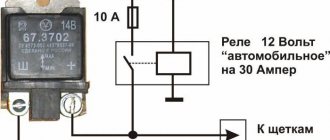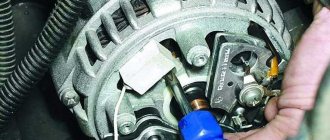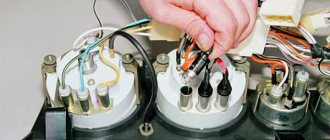Constant undercharging of the battery or its absolute discharge at the most inopportune moment is a headache for many car owners. One source of these problems may be the generator. But how to check it? Perhaps it's not his fault at all? Let's figure out together how much the generator must produce for the normal functioning of all car systems and maintaining the battery in a charged state.
How to check the operation of the generator
The battery in a car is an important element of the system, which is responsible for providing the car’s on-board network with electricity. The generator is used to charge the battery while it is active. Unstable operation of a device generating electricity causes a voltage drop in the network and failure to restore the capacity of the power source.
Normal generator performance means timely and complete replenishment of the battery charge level, which decreases under load. Checking the battery charge level from the generator is simple and can be done by the car owner himself.
Diagnostics of an automotive energy-generating device includes a visual inspection of the unit, its elements and related parts, as well as voltage and current measurements. At least twice a year, you should check the tension of the drive belt, excessive weakening of which leads to a decrease in the performance of the generator, and sometimes can lead to breakdown of the device. Once a year, you can check equipment elements - fasteners, diode bridge, voltage regulator and others. Timely maintenance of the battery will also guarantee the absence of problems - cleaning the terminals, adding distilled water.
Diagnostics of indicators such as voltage, current, resistance are also necessary twice a year. To carry it out, you will need special devices - a voltmeter, multimeter or load fork.
Reasons for failure
If the symptoms described below appear, carry out diagnostics. You can do it yourself or take the car to a car service. To determine the cause of the failure, special equipment is needed. If you decide to figure it out yourself, master a multimeter tester.
Five possible sources of difficulty are described below:
bearing wedge (lubricant is used up, sometimes the belt breaks - you will need to replace or rebuild the unit);
the winding has burned out (a common cause is the reagents used to treat winter roads);
brush wedge (cause - wear of graphite cores);
the regulator relay is faulty (this element prevents the battery from overcharging and stabilizes the voltage);
The diode bridge is broken.
What kind of charging should go to the battery from the generator?
It is traditionally believed that 13.5-14.5V should be supplied by the generator to the battery and this is absolutely enough to replenish the battery costs.
It is worth considering that using a battery with a higher power in a car than the manufacturer recommends also requires the installation of a more productive generating device.
It is necessary to take into account the load that the generator must withstand - it is calculated based on the maximum indicators of all electrical appliances and car systems.
Do not forget that the charging current from the energy-generating device will allow you to start the car in the cold season. In order to avoid problems with starting the car, we recommend purchasing generating equipment, the charge current of which will be approximately 10% of the capacity of the power source. That is, a battery of 100 A/h requires a generator that can produce 10A. Please note that for many cars, 100 amp equipment will operate at its maximum capacity, because the power consumption of the automotive system is in the region of 80 amps. Therefore, the choice of a source generating energy must take into account both the battery capacity and network consumption.
A few words about electrolyte
One of the main indicators by which you can judge the health of a battery is the electrolyte level. The voltage of the power supply depends on it under different operating modes.
In the process of discharging the battery, acid is consumed, the share of which in the total volume of liquid is a third (35-36%).
The result is a decrease in the density of the liquid. When the battery is charged, the reverse process occurs.
In such a situation, water is consumed, and acid, on the contrary, is formed. As a result, the density of the electrolyte increases.
In the normal state, when the battery voltage is 12.7 V, the density is 1.27 g/cc. Moreover, all parameters directly depend on each other.
How to check the alternator voltage on the battery
The potential difference can be diagnosed in two ways - directly at the generating equipment and through the battery. The generator is directly connected to the power source with a thick wire, therefore, to check the level of potential difference, you can measure the voltage at the power source. To do this, you will need special devices - a voltmeter, multimeter or load plug.
The wires of the first measuring instruments are connected to the battery in any sequence. The plug must be connected to the battery terminals with strict observance of polarity. It is generally accepted that the normal voltage in the network should not be lower than 12 volts. At idle speed without turning on all the electrical appliances of the car, this indicator should be at the level of 13.5-14V. A drop in voltage values to 13.3-13.8 volts is considered acceptable.
At the same time, using conventional testing equipment, you can check the resistance of the generator elements - rotor, stator and diode bridge. Diagnostics of rotary equipment is carried out by its winding. It is necessary to connect the probes of the device with slip rings. If the multimeter gives readings from 2, 3 to 5.1 ohms, then this element is working. The current consumption of the winding should be within 3-4.5 amperes.
Its normal resistance is 0.2 Ohm. The diode bridge is checked by the presence or absence of resistance, the indicators do not matter. The only thing worth considering is that there should not be a zero dimension. Measurements are carried out in pairs - positive output and all plates on this side or minus and all elements.
We remind you that for normal charging of a car battery, the voltage supplied by the generator must be from 13.5 to 14 volts.
Consequences of overcharging
So, for those who believe that all this is not serious and you can ride with it, I’ll dedicate it to you, I’ll break it down point by point:
- Overcharging causes the electrolyte to boil, it splashes onto the surface of the battery, and then flows onto many parts under the hood, for example: - terminals, pipes, body metal, radiator, wires, etc. Since there is acid present here (even if not concentrated), it can still corrode everything that I have listed for you, even if not immediately, but it will do it.
- Terminal oxidation. Since acid gets on the terminals, they will oxidize very quickly and a green coating will appear.
- The electrolyte level drops, the lead plates are exposed, but the charge continues! Thus, they will heat up, which has a negative effect on them - if you do not dry them out for a long time, they will “crumble”, the banks may short out, or the battery will die altogether. Just throw away the battery.
- Since the electrolyte evaporates, and these are essentially explosive gases (oxygen and hydrogen), the battery itself can explode, and it won’t seem like much. The entire engine compartment will be covered in acid.
- Some fuses may fail because they are not designed for 17 Volts.
- If the regulator relay is covered, then sometimes it can heat up, to such an extent that it almost melts, and this can indirectly cause a fire, or the wiring will get better.
Fix this breakdown, it's serious! Believe me! My battery exploded on an old VAZ .
As you can see, everything is banal and simple, but these simple “little things” make up complex things or entire systems, such as an electrical circuit: generator – battery – starter.
I think this article was useful to you, read our AUTOBLOG, there will be many more interesting things.
( 17 votes, average: 4.00 out of 5)
Constant undercharging of the battery or its absolute discharge at the most inopportune moment is a headache for many car owners. One source of these problems may be the generator. But how to check it? Perhaps it's not his fault at all? Let's figure out together how much the generator must produce for the normal functioning of all car systems and maintaining the battery in a charged state.
How many amperes does a car alternator produce per battery?
The current strength required by the electrical system of each car is individual and depends on the number of electricity consumers and their values. And also the charge current must be sufficient to charge the power source.
It is worth noting that ampere readings appear only when there is a load in the vehicle’s electrical system and, accordingly, the battery is discharged. After starting the car engine, the charging current is about 6-10 amperes and drops over time, because the battery is charging, taking on the main energy consumption. If you turn on additional equipment - headlights, radio or heated mirrors, you can see an increase in the charging current values.
When purchasing a generator, pay attention to its technical characteristics, which the manufacturer indicates on the case - that’s where you will find information about the maximum current that will flow to the battery.
In the table below you can see the approximate current values that the generator shows at different loads.
Table 1. How many amperes the generator produces under load.
Battery charging circuit
For a general understanding of the reasons for overcharging, first consider the battery charging circuit diagram. And although it is structurally different on different cars, the general principle of construction is the same.
This circuit includes:
- Generator.
- Rectifier block (diode bridge).
- Relay regulator.
- Fuse box.
- Egnition lock.
- Charge indicator lamp.
- Battery
The charging system works using the example of the VAZ 2106 and other cars from the “VAZ classic” series as follows:
- After starting the power plant, through a belt drive, the crankshaft begins to rotate the generator rotor, as a result of which this unit generates electricity.
- Since automobile generators use alternating current, the generated energy goes to the rectifier unit, where alternating current is converted into direct current.
- After the rectifier unit, the electricity is supplied to the relay regulator, whose task is to maintain the voltage in a given range.
- After the regulator, the electrical energy passes through the circuit through the fuse box, the ignition switch and the charge indicator lamp, then returns to the output of the generator, and from there it is supplied to the battery.
The detailed diagram is shown below.
Signs of a generator malfunction
In modern cars, breakdowns of the electrical system are one of the most common. A large number of electronics requires particularly careful monitoring of the operation and condition of the generator and battery, because their failure can immobilize the car. The most common signs of a generator malfunction are:
- battery indicator light on the instrument panel;
- unstable operation of the battery (its boiling over or undercharging);
- different intensity of headlights;
- extraneous sounds from the generator.
If you notice incorrect operation of the car, then perhaps the battery charging current from the generator is insufficient.
All malfunctions of electrical equipment, which includes the vehicle’s energy-generating device, are mechanical (deformation or breakage of fasteners, housing, malfunction of bearings, pressure springs, drive belt, etc.) or electrical (winding breaks, diode bridge malfunctions, burnout or wear of brushes , short circuits between turns, breakdowns, etc.).
Don’t write off a non-working generator: find out if there are repair kits and spare parts. Replace them if possible. If you cannot carry out repair work yourself, then take the generator to a workshop. Many craftsmen will be able to restore the unit at no extra cost and in the shortest possible time.
However, some breakdowns require the purchase of a new device that generates electricity. For example, a failing bearing that is soldered into the generator housing cannot be restored or replaced in most cases.
Remember that failure of this unit can be caused not only by wear and corrosion, but also by poor quality of elements and components; excessive load; external influence of salts, liquids, temperatures.
Breaks in the winding
If there is a break in the excitation winding, then the generator does not charge. This is determined simply. It is enough to touch the generator with your hand.
If the winding breaks, the device will heat up. To diagnose more accurately, the end of the excitation winding is disconnected from the brush and connected to a terminal on the generator. The measurement is carried out using a multimeter from the battery.
If there are breaks, the multimeter will not show anything. If a signal lamp is used instead of the device, it will not light up. In order to find the problematic coil, wires from the battery are connected to each of them in turn.
If the break is inside, the coil is replaced. External breaks are removed using a soldering iron.
Low voltage on-board network of VAZ 2114: causes and solutions
Every car breakdown is a very unpleasant situation for any driver. A malfunction such as low on-board voltage on a VAZ 2114 can be a serious test for a person who does not have specific knowledge in the field of electrical engineering. This article will help you understand all the causes of this defect and teach you how to fix the problem yourself.
Troubleshooting yourself
It’s wise to start car repairs by looking for the simplest faults, in our case mechanical damage. You should inspect the drive belt, adjust its tension, and rule out a malfunction of its brush mechanism. You can tighten the fastenings of the power wires. If this work does not bring results and the on-board network voltage on the VAZ 2114 is still low, then you can begin to disassemble the entire assembly and carry out a full diagnosis of it.
The stages of work, as in the first case, should preferably be carried out from simple to complex:
What do you need to remember?
We looked at the main reasons for the battery not charging from the generator. According to statistics, most motorists with such problems turn to service. This is normal, but the information will be useful to you in order to understand the cause of the breakdown on the spot. In addition, if you are aware of the situation, it will be difficult for cunning car service employees to extract extra money from you for repairs.
It’s one thing when you tell the mechanic, “I need to tighten the alternator belt,” and quite another, “I’ve got something broken there.” For this you will be charged twice as much.
And finally, what you need to remember when using the battery.
In both cases, you need to contact a specialist to fix the problem.
That's all on this issue. We wish you good luck on the roads! And we are waiting for your comments on the article! Return to content
My alternator belt is constantly squealing. Too lazy to pull it up. That's how I go. But the battery seems to be charging normally. Ugh, ugh
Driving without a seat belt is like walking with your pants down. Damn quitters!
Recently the alternator belt broke. It was good at home. I drove on the battery for only 10 minutes. It was almost completely dead.
It infuriates such smart morons who, after reading such articles, come “I need to tighten my belt” or “I need to clean the injectors”, and then “oh it didn’t help, what should I do, I don’t want to pay, there are no changes”, do a diagnosis, then decide to do it or not, stars.
Help, the battery on the Ford Skate is not charging, everything checked the generator, the working belt is normal, the light on the battery is on and is not charging
The battery has failed to charge (the lamp comes on). I got to the market and went about my business. The car cooled down, started up, charging appeared, some time after warming up, the battery light came on again (the brushes are on their last legs, and when they heat up, the gaps change). Definitely BRUSHES on the generator. Moreover, they departed without repair for almost 200 thousand km. not counting how much I was stuck in traffic jams. (new gen. 17,000 RUR VALEO) (relay regulator 4,000 RUR) Replaced the brushes, the problem disappeared. Many people write on forums that they use brushes from just about anything, from an angle grinder, etc. This is not entirely correct and will not last long. There are three types of brushes: carbon brushes - designed for 220 volts and a small amperage, copper-plated carbon brushes - used in battery tools (amperage is not large up to 15A), copper-graphite brushes - these are what you need for a car, you have a battery of 50-60 amperes. Finding such brushes is problematic, so you buy a relay regulator from VOLGA and resolder the brushes (the price is 300 rubles). I took a different route, bought a jumper from a classic Lada for 60 rubles (two brushes in a plastic case) and unsoldered the brushes, but unlike the classic, unlike the Volga, they are a little thicker, which is easily adjusted with sandpaper.
Vova, it’s very similar if you check the serviceability of the generator when it’s cold.
One day, on the way to the dacha, the generator broke down, I drove to the dacha and returned home. A total of 235 km. Naturally without music, air conditioning and high beams.
By the way, problems with charging on all those cars that I personally had to use occurred extremely rarely. For the most part, this began after the 90-100 thousand mileage mark. Priora is no exception. If on a relatively new car, when the new generator and all other components are in perfect order, these problems are practically eliminated, then on a used car, problems with battery charging can occur quite often.
Low voltage on-board network of VAZ 2114: causes and solutions
Every car breakdown is a very unpleasant situation for any driver. A malfunction such as low on-board voltage on a VAZ 2114 can be a serious test for a person who does not have specific knowledge in the field of electrical engineering. This article will help you understand all the causes of this defect and teach you how to fix the problem yourself.
Troubleshooting yourself
It’s wise to start car repairs by looking for the simplest faults, in our case mechanical damage. You should inspect the drive belt, adjust its tension, and rule out a malfunction of its brush mechanism. You can tighten the fastenings of the power wires. If this work does not bring results and the on-board network voltage on the VAZ 2114 is still low, then you can begin to disassemble the entire assembly and carry out a full diagnosis of it.
The stages of work, as in the first case, should preferably be carried out from simple to complex:











